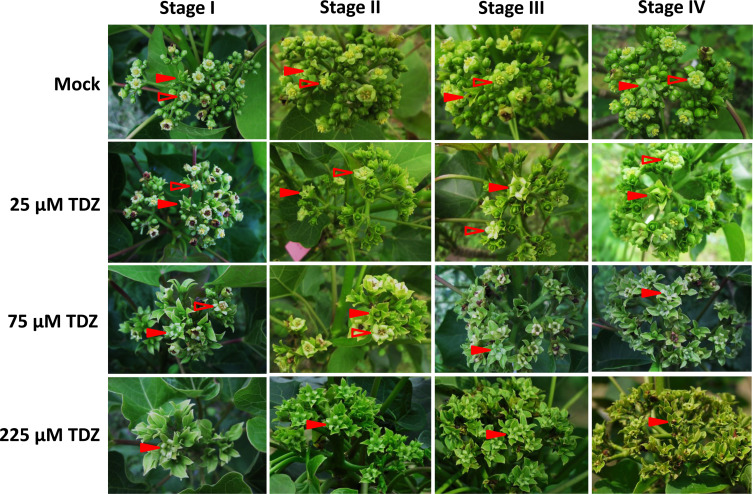In the context of increased demand for biofuels, the potential of the non-food species Jatropha curcas L. (hereafter referred to as Jatropha) has been recognized because the quality of its seed oil is suitable for biodiesel production and it is able to grow in unproductive subtropical or subdesert soils. Prof. Xu Zengfu’s team of Xishuangbanna Tropical Botanical Garden (XTBG) has previously reported that 6-benzyladenine (BA, a synthetic compound with CK activity) treatment significantly increased the number of female flowers per inflorescence and induced bisexual flowers. However, BA treatment produced too many flowers (both male and female), most of which were not well developed, and did not contribute to final seed yield.
Thidiazuron (TDZ), a diphenylurea derivative, has been reported to have a high degree of intrinsic CK-like activity, much higher than that of BA and it functions as an inhibitor of CK oxidase activity mainly through a non-competitive mechanism that is different from that of BA. In a recent study, the researchers reported the effects of Thidiazuron on sex expression in Jatropha through the exogenous application of various concentrations of TDZ onto inflorescence meristems (IMs) at four developmental stages.
They found that treatment with Thidiazuron promoted the pistil development in Jatropha flowers, resulting in an increase in the number of female flowers ( i.e. flowers with only a pistil). Furthermore, the TDZ treatments reversed the abortion of stamens in some female flowers when the second, third and fourth flowers appeared the primordial stamen. They ultimately resulted in the formation of bisexual flowers (flowers with both pistils and visible stamens), whereas there were only vestigial stamens in the control female flowers.
The study showed that TDZ treatment increased the number of female flowers by promoting pistil development and induced bisexual flowers by reversing stamen abortion during Jatropha flower development, which indicated that Cytokinin was required for development of both pistils and stamens in Jatropha. As both female and bisexual flowers influence seed yield, TDZ treatment can significantly increase the number of fruits, and thus final seed yield.
The study entitled “Thidiazuron increases fruit number in the biofuel plantJatropha curcasby promoting pistil development” has been published online in Industrial Crops and Products.
Contact
Prof. XU Zengfu Ph.D Principal Investigator
Key Laboratory of Tropical Plant Resources and Sustainable Use, Xishuangbanna Tropical Botanical Garden, Chinese Academy of Sciences, Menglun 666303, Yunnan, China
E-mail: zfxu@xtbg.ac.cn
Tel: +86 691 8713051 
Effects of TDZ treatment on flower number and sex expression in Jatropha. Female and male flowers are indicated by solid triangles and hollow triangles, respectively. (Image by PAN Bangzhen) 
Effects of the 225 μM TDZ treatment on fruiting in Jatropha. (a) Mock; (b) stage I; (c) stage II; (d) stage III; (e) stage IV. The premature fruits are indicated by red arrows in (b)–(e). (Image by PAN Bangzhen)
|


